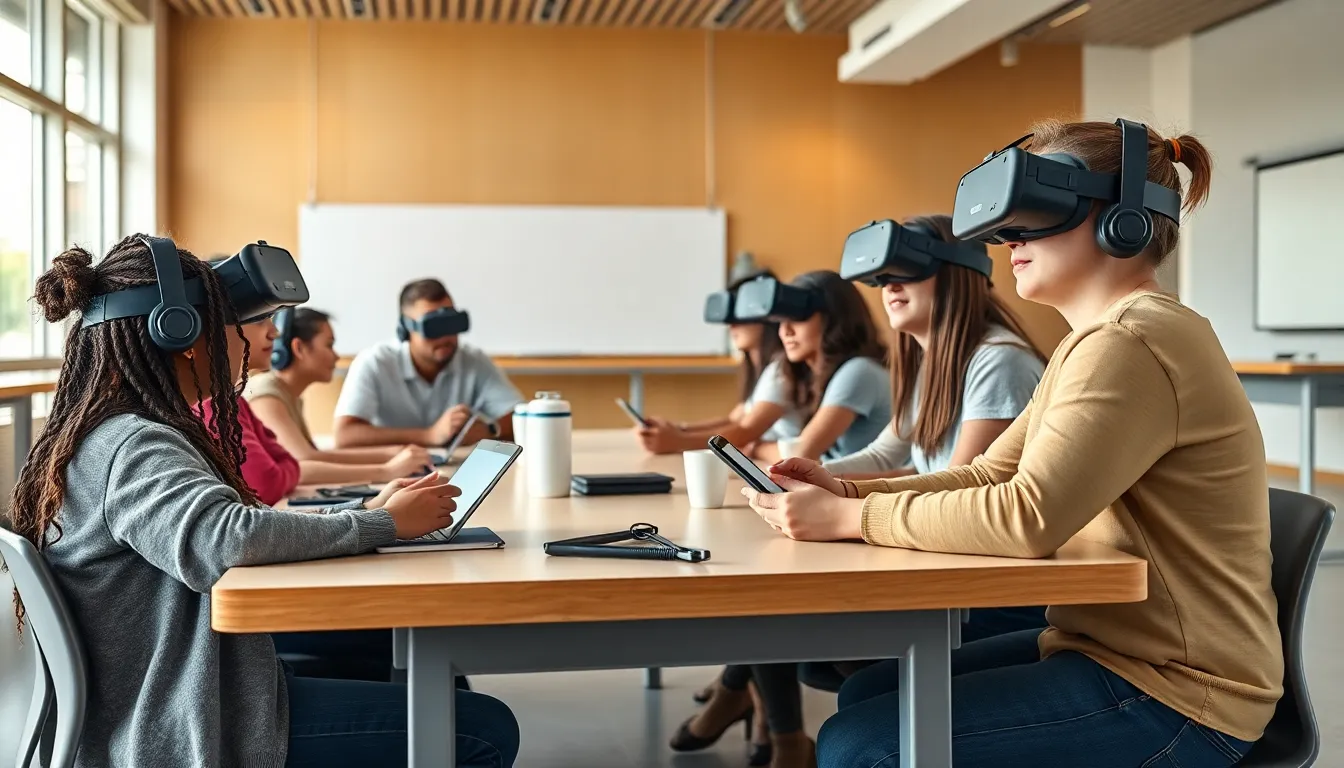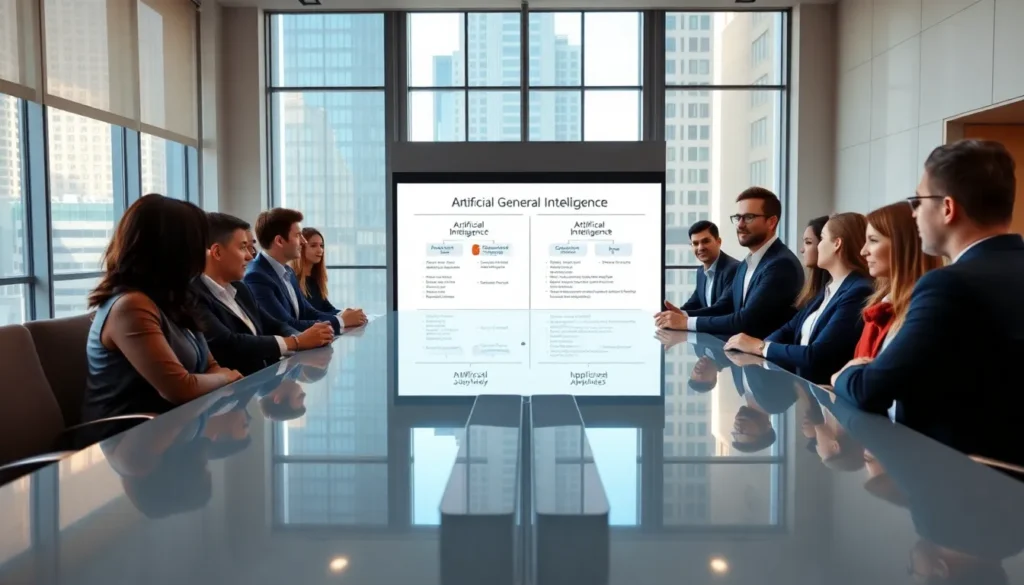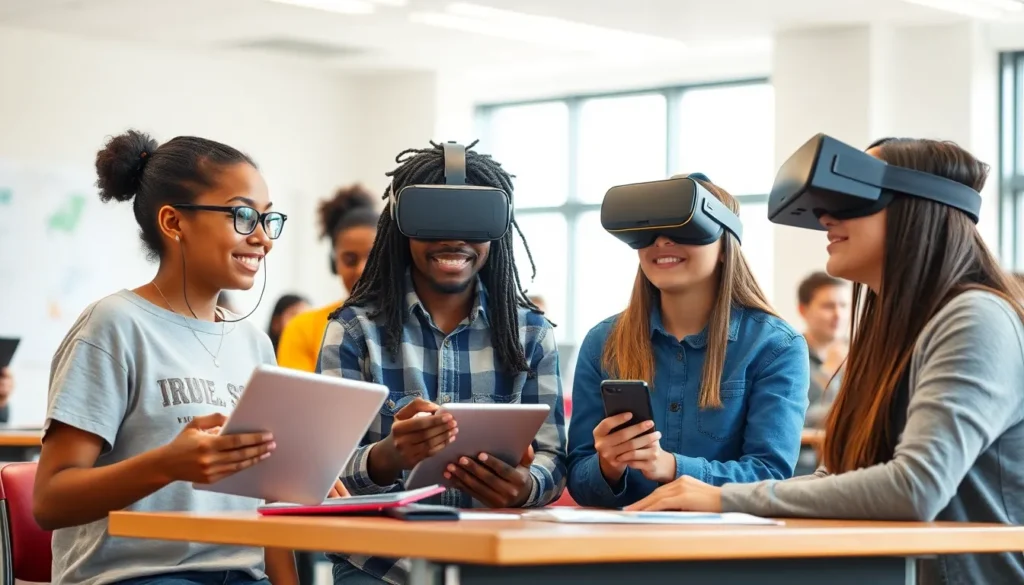Table of Contents
ToggleThe future of EdTech is like a rollercoaster ride—thrilling, a bit unpredictable, and full of surprises. As technology continues to evolve at lightning speed, classrooms are transforming into dynamic learning environments where students can engage and collaborate like never before. Gone are the days of dusty textbooks and rigid lectures; now, it’s all about interactive apps and virtual reality adventures that make learning feel like a game.
The Rise of EdTech
EdTech is increasingly becoming a central component in education. This evolution reflects a significant transformation in how learners engage with content.
Historical Context
Traditionally, education relied heavily on textbooks and direct instruction. The introduction of computers in the late 20th century marked the beginning of a gradual shift. By the early 2000s, the internet expanded access to information and learning resources. Classroom dynamics changed with the advent of online courses and educational software. These developments laid the groundwork for integrating technology into everyday learning experiences, ultimately sparking the rise of EdTech.
Current Trends
Current trends in EdTech focus on personalized learning and data-driven instruction. Adaptive learning platforms adjust content based on individual student performance. Mobile apps provide flexibility, enabling learning anywhere at any time. Gamification techniques engage students through interactive experiences. Virtual reality simulations create immersive environments for exploration and experimentation. Collaborative tools enhance communication between students and educators. These trends illustrate the ongoing commitment to making education more engaging and accessible for diverse learners.
Innovations Shaping the EdTech Future

Innovations in educational technology are revolutionizing learning experiences. Key advancements include artificial intelligence and virtual reality applications.
Artificial Intelligence in Education
Artificial intelligence transforms education by personalizing learning experiences. AI-driven platforms analyze student performance, adapting content to individual needs. Intelligent tutoring systems provide real-time feedback, offering tailored support. Automation streamlines administrative tasks, freeing educators to focus on teaching. Voice-activated learning assistants enhance accessibility, allowing students to engage more interactively. By utilizing data to inform instructional strategies, AI significantly improves learning outcomes.
Virtual and Augmented Reality Applications
Virtual reality applications create immersive educational environments. Students can explore historical sites or dive into scientific simulations. AR applications overlay digital information onto the physical world, enhancing classroom engagement. These tools foster collaboration as learners interact in shared, virtual spaces. Additionally, exposure to new experiences cultivates curiosity and drives motivation. Both virtual and augmented reality enrich traditional lessons, making complex subjects more tangible and comprehensible.
Challenges Facing the EdTech Industry
The EdTech industry encounters several significant challenges as it evolves. Addressing these obstacles is crucial to ensuring effective learning experiences for all.
Equity and Access Issues
Equity in education remains a pressing concern. Many students lack reliable access to technology and high-speed internet. Digital divides often hinder marginalized communities, making it difficult for them to benefit from innovative EdTech tools. Schools in low-income areas frequently struggle to provide equal technological resources. Inclusive designs and programs can help bridge this gap, ensuring all learners gain the advantages of technology in education. Investment in infrastructure and community support is vital for enhancing access to quality EdTech solutions.
Data Privacy Concerns
Data privacy concerns rise as educational technology grows. Protecting sensitive student information becomes essential amid increasing data breaches and cyber threats. Many EdTech platforms collect vast amounts of personal data, raising questions about its security and usage. Compliance with regulations, such as FERPA and COPPA, requires strict adherence to safeguarding information. Schools and companies must prioritize transparency, clearly communicating how data is used and stored. Building trust among educators and students hinges on robust data privacy measures.
The Role of Educators in EdTech Evolution
Educators play a crucial role in the evolution of EdTech by adapting to new technologies and effective teaching methodologies. Their continuous learning shapes how technology integrates into the classroom.
Teacher Training and Support
Training programs must equip teachers with skills to effectively use EdTech tools. Focused workshops and ongoing professional development promote familiarity with the latest educational technologies. Support systems, such as mentorship and peer collaboration, enhance educators’ confidence in utilizing digital resources. Adequate training fosters innovation and encourages the exploration of personalized learning strategies. Access to quality resources enables educators to design engaging lessons that leverage technology’s potential. Therefore, comprehensive support mechanisms elevate teaching practices and enrich student learning experiences.
Collaboration Between Educators and Tech Developers
Collaboration between educators and tech developers enhances the effectiveness of EdTech solutions. Input from teachers informs the design of user-friendly applications and tools tailored to classroom needs. Close partnerships facilitate the development of innovative teaching resources aligned with curriculum goals. Regular feedback loops encourage developers to adjust platforms based on real classroom experiences. Joint efforts ensure that technological advancements are practical, relevant, and beneficial for educators and learners. Engaging educators in the development process fosters a sense of ownership and commitment to new technologies, leading to successful implementation.
Conclusion
The future of EdTech is bright and full of potential. As technology continues to evolve it’s clear that the educational landscape will shift dramatically. Innovative tools like AI and VR are set to redefine how students learn and interact with content.
While challenges such as equity and data privacy persist the commitment to addressing these issues will pave the way for a more inclusive educational environment. Educators play a pivotal role in this transformation by adapting to new technologies and embracing continuous learning.
With a focus on collaboration between teachers and tech developers the EdTech industry can create solutions that truly enhance the learning experience. This evolution promises to engage students in ways that were once unimaginable making education more accessible and enjoyable for everyone.







